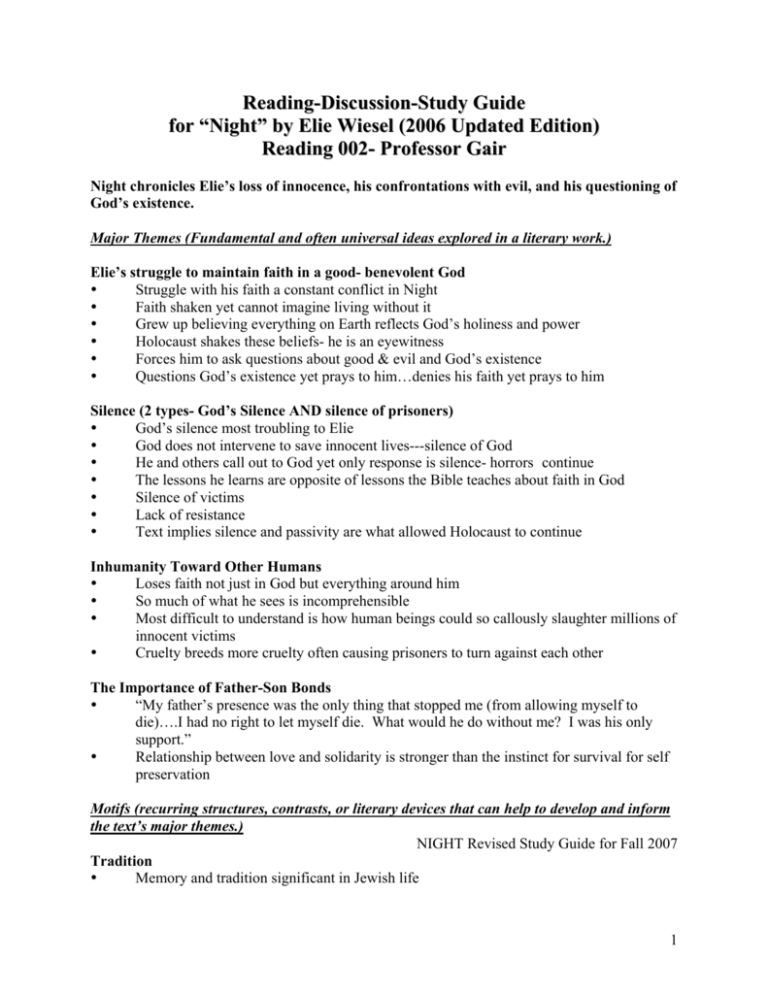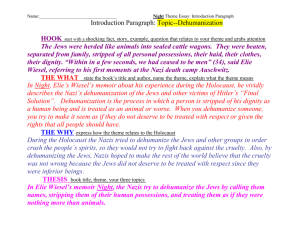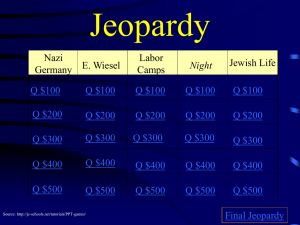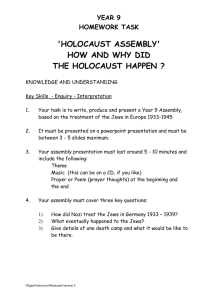Reading-Discussion-Study Guide for “Night” by Elie Wiesel
advertisement

Reading-Discussion-Study Guide for “Night” by Elie Wiesel (2006 Updated Edition) Reading 002- Professor Gair Night chronicles Elie’s loss of innocence, his confrontations with evil, and his questioning of God’s existence. Major Themes (Fundamental and often universal ideas explored in a literary work.) Elie’s struggle to maintain faith in a good- benevolent God y Struggle with his faith a constant conflict in Night y Faith shaken yet cannot imagine living without it y Grew up believing everything on Earth reflects God’s holiness and power y Holocaust shakes these beliefs- he is an eyewitness y Forces him to ask questions about good & evil and God’s existence y Questions God’s existence yet prays to him…denies his faith yet prays to him Silence (2 types- God’s Silence AND silence of prisoners) y God’s silence most troubling to Elie y God does not intervene to save innocent lives---silence of God y He and others call out to God yet only response is silence- horrors continue y The lessons he learns are opposite of lessons the Bible teaches about faith in God y Silence of victims y Lack of resistance y Text implies silence and passivity are what allowed Holocaust to continue Inhumanity Toward Other Humans y Loses faith not just in God but everything around him y So much of what he sees is incomprehensible y Most difficult to understand is how human beings could so callously slaughter millions of innocent victims y Cruelty breeds more cruelty often causing prisoners to turn against each other The Importance of Father-Son Bonds y “My father’s presence was the only thing that stopped me (from allowing myself to die)….I had no right to let myself die. What would he do without me? I was his only support.” y Relationship between love and solidarity is stronger than the instinct for survival for self preservation Motifs (recurring structures, contrasts, or literary devices that can help to develop and inform the text’s major themes.) NIGHT Revised Study Guide for Fall 2007 Tradition y Memory and tradition significant in Jewish life 1 y y Customs, observances, traditions passed down by generations Nazi genocide an attempt to wipe out and entire people, including all sense of national and cultural identity Religious Observance y First section of book, frequent mentions of religious observances y Nazis desecrate Sabbath and his synagogue y By end of text almost all mentions of observance vanish y Observance ceases to be part of his life….the loss of faith in God yet the wish his father had a religious memorial enhances his conflict Symbols (objects, characters, figures, or colors used to represent abstract ideas and concepts.) Fire y y y y Symbolizes cruel power Agent of destruction in crematoria The wicked use fire to punish the innocent Madam Schacter Night y Darkness and night symbolizes a world without God y His life is darkness…he arrives at night and it is night when the prisoners start their march to Buna. YOU MUST USE THE NEWEST EDITION, THE UPDATED TRANSLATION PUBLISHED IN 2006. It is this version which we will use in class and will match this study guide! Reading Assignment 1 -Read Pages Preface, Forward and pages 3 to 22- Defining Identity- Due Date_____________ 1. How important is religion to the way Eliezer defines his identity? 2. What does the word “religion” mean to you? 3. What do the Jews of Sighet know about the outside world in 1941? How do they respond to what they know? 4. How do the Jews of Sighet react to the arrival of the Germans? The creation of the ghettos? Their own deportation? How do you account for these responses? Reading Assignment 2- Read Pages 23-46-Initiation to AuschwitzDue Date____________ To Read You are likely to encounter these terms and names as you read. 2 Auschwitz-Birkenau—established in 1940 as a concentration camp, a killing center was added in 1942 at Birkenau. Also part of the huge camp complex was a slave labor camp known as Buna-Monowitz. Concentration camp—a prison camp in which individuals are held without regard for accepted rules of arrest and detention. The Nazis constructed concentration camps to hold Jews, “Gypsies,” communists, and others considered “enemies of the state.” Death camp—a camp where the Nazis murdered people in assembly-line style. The largest death camp was Auschwitz-Birkenau. The term was also used for concentration camps such as Bergen-Belsen and Dachau where thousands died of starvation, disease, and maltreatment. Kapo—a prisoner forced to oversee other prisoners. Mengele, Josef (1911–1979)—senior SS physician at Auschwitz-Birkenau from 1943–1944. He carried out “selections” of prisoners upon their arrival at the camp and conducted experiments on some of those prisoners. “Selection”—the process the Nazis used to separate those prisoners who would be assigned to forced labor from those who were to be killed immediately. SS—in German, Schutzstaffel; the elite guard of Nazi Germany. It provided staff for the police, camp guards, and military units within the German army. 1. Why do you think the Germans take away the inmates’ personal belongings? Their clothing? Why do they cut off their hair? Tattoo a number on each person’s arm? 2. How does Eliezer respond when his father is beaten for the first time? How does that response affect the way he sees himself? What does he fear is happening to him? 3. Wiesel, in recounting the first night in the concentration camp says, “Never shall I forget that night, the first night in the camp, which has turned my life into one long night.…” What does it mean for a life to be turned into “one long night”? Reading Assignment 3- Read Pages 47-65 Identity and IndifferenceDue Date____________ 1. Give examples of the ways Eliezer’s relationship with his father is changing. What is prompting those changes? 2. What does Eliezer mean when he refers to his father as “his weak point”? Why has he come to view love as a weakness? 3. When the young boy is hanged, a prisoner asks, “Where is God now?” Eliezer thinks to himself, “He is hanging here on this gallows.…” What does this statement mean? Is it a statement of despair? Anger? Or hope? Discuss the meaning of the word resistance at Auschwitz. Reading Assignment 4- Read Pages 66-84- Faith and Survival at Auschwitz- Due Date_________________ 1. On Rosh Hashanah, Eliezer says, “I was alone—terribly alone in a world without God and without man. Without love or mercy. I had ceased to be anything but ashes.…” Eliezer is describing himself at a religious service attended by ten thousand men, 3 2. Why does Eliezer direct his anger toward God rather than the Germans? What does his anger suggest about the depths of his faith? 3. How has the relationship between Eliezer and his father changed during their time at Auschwitz? What has each come to represent to the other? Reading Assignment 5 Read Pages 85-112- The Importance of Memory- Due Date_______________ 1. What does Eliezer mean when he writes that he feels free after his father’s death? Is he free of responsibility? Or is he free to go under, to drift into death? 2. Eliezer later states, “After my father’s death, nothing could touch me any more.” What does he mean by these words? What do they suggest about his struggle to maintain his identity? 3. In the next to the last sentence in the book, Eliezer says that when he looks in a mirror after liberation, he sees a corpse gazing back at him. He ends the book by stating, “The look in his eyes, as they stared into mine, has never left me.” What does that sentence mean? 4. Write your response to the entire book. APPENDIX A Timeline of the Holocaust Entries in italics refer to events described or alluded to in Night. 1933 The Nazi party takes power in Germany. Adolf Hitler becomes chancellor, or prime minister, of Germany. Nazis “temporarily” suspend civil liberties for all citizens. They are never restored. The Nazis set up the first concentration camp at Dachau. The first inmates are two hundred Communists. Books contrary to Nazi beliefs are burned in public. 1934 Hitler combines the positions of chancellor and president to become “Fuhrer,” or leader, of Germany. 1935 Jews in Germany are deprived of citizenship and other fundamental rights. The Nazis intensify persecution of political dissidents and others considered “racially inferior” including “Gypsies,” Jehovah’s Witnesses, and homosexuals. Many are sent to concentration camps. 1936 The Olympic games are held in Germany; signs barring Jews from public places are removed until the event is over. 1938 German troops annex Austria. On Kristallnacht (the “Night of Broken Glass”), Nazi gangs physically attack Jews throughout Germany and Austria. 1939 In March, Germany takes over a neighboring nation, Czechoslovakia. On September 1, Germany invades Poland. World War II begins in Europe. Hitler orders the systematic murder of the mentally and physically disabled in Germany and Austria. Polish Jews are ordered to register and relocate. They are also required to wear armbands or yellow stars. 1940 Nazis begin deporting German Jews to Poland. Jews are forced into ghettos. Germany conquers one nation after another in Western Europe including the Netherlands, Denmark, Norway, Belgium, Luxembourg, and France. With Germany’s backing, Hungary annexes parts of Romania, including Sighet and other towns in northern Transylvania. 4 1941 Germany attacks the Soviet Union. Jews throughout Europe are forced into ghettos and internment camps. Mobile killing units begin the systematic slaughter of Jews. In two days, one of those units was responsible for the murder of 33,771 Ukrainian Jews at Babi Yar—the largest single massacre of the Holocaust. Hungary deports 17,000 foreign and “stateless” Jews. Several thousand are used as slave laborers. The Nazis massacre the rest. The first death camp at Chelmno in Poland begins operations. Germany, as an ally of Japan, declares war on the United States immediately after the bombing of Pearl Harbor. 1942 At the Wannsee Conference, Nazi offi- cials turn over the “Final Solution”— their plan to kill all European Jews—to the bureaucracy. Five more death camps begin operation in Poland: Majdanek, Sobibor, Treblinka, Belzec, and Auschwitz-Birkenau. March: About 20 to 25 percent of the Jews who would die in the Holocaust have already perished. The ghettos of Eastern Europe are emptied as thousands of Jews are shipped to death camps. The United States, Britain, and the Soviet Union acknowledge that Germans were systematically murdering the Jews of Europe. 1943 February: About 80 to 85 percent of the Jews who would die in the Holocaust have already perished. April: Jews in Poland’s Warsaw Ghetto strike back as the Nazis begin new rounds of deportations. It takes nearly a month for the Nazis to put down the uprising. 1944 March: Hitler occupies Hungary; by June, the Germans are deporting twelve thousand Hungarian Jews a day to Auschwitz. 1945 January: As the Russian army pushes west, the Nazis begin to evacuate death camps, including Auschwitz. April: American forces liberate the prisoners in Buchenwald. May: World War II ends in Europe with Hitler’s defeat. The Holocaust is over; about one-third of all the Jews in the world are murdered and the survivors are homeless. 1946 An International Military Tribunal created by Britain, France, the United States, and the Soviet Union tries Nazi leaders for war crimes and crimes against humanity in Nuremberg. APPENDIXB A Guide to Jewish References in Night Elie Wiesel grew up in a traditional Jewish community. Throughout Night, there are references to ideas, practices, and events important to that community. Brief definitions of those terms are provided. The page numbers refer to pages in the Bantam paperback edition of Night. Beadle—a caretaker or “man of all work” in a synagogue. (page 1) Cabbala—Jewish mysticism. Followers believe that every aspect of the Torah has hidden meanings that link the spiritual world to everyday life. The teachings of the cabbala can be found in the Zohar, which was compiled in the thirteenth century. (page 1) Hasidism—a Jewish reform movement inspired by the cabbala that spread through Eastern Europe in the 1700s. For Hasidic Jews, the divine presence is everywhere, in everything. They therefore try to live a life of total dedication to God. The word hasidic is an adjective used to describe followers of Hasidism or some aspect of their practices and beliefs. (page 1) Job—a biblical figure who questioned why the just must suffer while the wicked flourish. (page 42) Kaddish —a prayer Jews recite in memory of a loved one. The prayer praises and reaffirms a belief in one God. (page 31) Maimonides—a great Jewish scholar who lived in the twelfth century. (page 1) 5 Messiah—the savior and deliverer of the Jewish people. Jews believe the Messiah is yet to come; Christians believe that Jesus was the Messiah. (page 42) Palestine—territory assigned to the British in 1920 by the terms of the post-World War I treaty with Turkey, the former ruler of the area. British control ended in 1948 when the territory was divided into the State of Israel and the Kingdom of Jordan. Palestine is the ancient homeland of the Jewish people. (page 6) Passover—a Jewish holiday that is celebrated for eight days each spring to recall the Exodus of the Jewish people from Egypt where they were held in slavery. (page 8) Pentecost—the Jewish holiday that commemorates the revelation of the Law on Mount Sinai. Called Shavuot in Hebrew, it is celebrated about seven weeks after Passover. (page 10) Phylacteries (tefilin)—two small leather boxes containing four excerpts from the Bible. One box is strapped to an arm and the other to the forehead during weekday morning prayers. Tefilin help religious Jews focus their entire being on God as they recite their weekday morning prayers. (page 13) Rosh Hashanah—the Jewish New Year. The holiday, which falls in September or October, marks the beginning of a ten-day period of divine judgment—a time when Jews believe God calls them to account for their actions. These days are marked by repentance, regret, and resolutions to make amends to one another as well to God. The period ends on Yom Kippur. (page 63) Synagogue—a Jewish house of prayer. (page 1) Talmud—from a word that means study or learning. A collection of rabbinical teachings and commentaries on the Torah, the Five Books of Moses. (page 1) Temple, The—a reference to the Temple in Jerusalem, which the Romans destroyed in 70 A.D. It was the center of Jewish worship in ancient times. Today Jews recall its destruction in their daily prayers. (page 1) Yom Kippur—the Jewish Day of Atonement, a fast day devoted to prayer. It marks the end of the ten most solemn days in the Jewish calendar, which begins with Rosh Hashanah. (page 65) Zohar—the Book of Splendor; a commentary on the Five Books of Moses and the major work of the cabbala. (page 3) Zionism—the belief that Jews must once more become a nation with a land of their own in Palestine. A commitment to Zionism led a number of European Jews to settle in Palestine in the early 1900s. (page 6) Witness to History When asked why he became a writer, Elie Wiesel responds by speaking of those who did not survive to tell their stories: I owe them my roots and memory. I am duty-bound to serve as their emissary, transmitting the history of their disappearance, even if it disturbs, even if it brings pain. Not to do so would be to betray them, and thus myself. .- Why does Elie Wiesel feel so strongly that he has an obligation to bear witness? What lesson does he want us to learn from his story? 6









